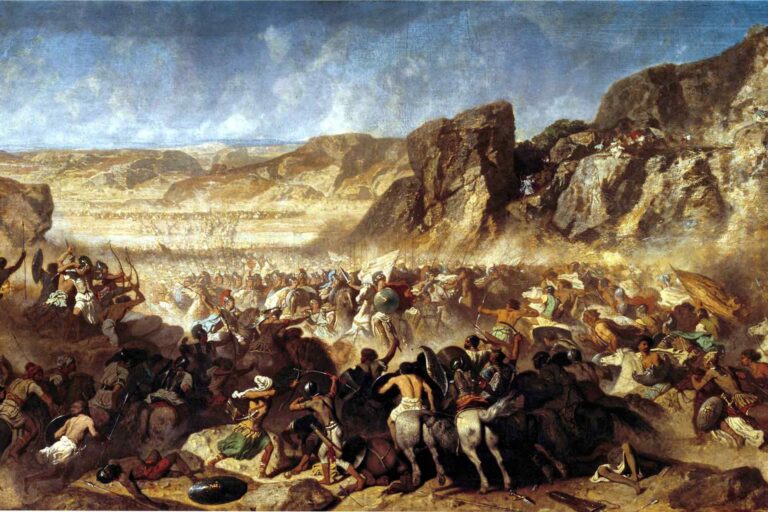A Brief Introduction to 22 Egyptian Gods
Delving into the Divinity of Egyptian Gods
The allure of Egyptian Gods has captivated scholars, enthusiasts, and the general public for centuries. The land of pyramids, the Nile, and enigmatic hieroglyphs is also home to a rich tapestry of deities, each with their unique narratives and spheres of influence. With its intricate interplay of power, love, betrayal, and redemption, this pantheon paints a vivid picture of how the ancient Egyptians perceived the world around them and their place within it. As we embark on this enlightening journey, let us delve deeper into the legends and stories of 22 of these iconic deities, unveiling their mysteries.

Ra’s Sun Boat Journey
Ra, the mighty sun god of ancient Egypt, was believed to travel across the sky in a sun boat. He emerged from the underworld each dawn and made his ascent, only to set and venture back into the underworld at dusk. This cyclic journey symbolized the constant notions of life, death, and rebirth. This Egyptian god
was depicted with a falcon head, and Ra believed to have created all forms of life.
The Sun plays a pivotal role in bestowing life, overseeing the maturation of harvests cultivated by humans. Recognizing its vital attributes, ancient Egyptians revered the Sun as a divine entity. Representing vitality, warmth, and development, the Sun, also known as Ra, was the cosmic architect and life’s beacon. Given Ra’s status as the universe’s originator and life’s fountainhead, his profound impact on the people solidified his place as one of the most revered deities, often regarded as the Supreme God or the King of Egyptian Gods.

Osiris, the First Mummified Egyptian God
Often depicted as a mummified king, Osiris was central to Egyptian afterlife concepts. Legends say he was the first to be mummified, setting a precedent for the Egyptian funerary customs. After his brother Set took Osiris’ life and dismembered him, his wife Isis diligently gathered all his parts and enveloped him, facilitating his resurrection. His resurrection story has also inspired many myths and rituals.
After his brief revival, he is alive long enough to impregnate Isis, resulting in the birth of Horus. As Horus’s birth followed the rejuvenation of Osiris, he symbolized fresh starts and was seen as the one to defeat the treacherous Set.

Anubis and the Sacred Scales
Anubis, recognized by his jackal head, wasn’t merely the god of mummification. He also played a pivotal role in the “Weighing of the Heart” ceremony, a crucial stage in the soul’s journey to the afterlife. Here, a deceased person’s heart was weighed against the feather of Ma’at to ascertain its purity. Anubis is also the Egyptian god that ushered souls to the underworld in addition to the protector of graves.

Bastet’s Dual Nature
Bastet, revered initially as a fierce lioness deity, underwent a significant transformation over time. From a goddess of warfare, she morphed into a more benign feline deity, symbolizing domesticity, music, and fertility. This transition showcases ancient Egypt’s fluid and evolving religious beliefs.
She was also the Egyptian goddess of pregnancy and childbirth. Scholars believe this was due to the fertility of domesticated cats.
Bastet’s widespread reverence was such that, in 525 BCE, during Cambyses II of Persia’s invasion of Egypt, he tactically leveraged the Egyptian god to ensure an Egyptian capitulation. Aware of the Egyptians’ profound respect for creatures, particularly felines, his troops adorned their shields with depictions of Bastet. They then gathered as many animals as possible, herding them towards the crucial city of Pelusium. Fearing the potential harm to these creatures and the possible wrath of Bastet, the Egyptians chose not to engage in battle and conceded.

Thoth: The Divine Scribe
Thoth, depicted with an ibis head, held the esteemed title of the god of wisdom and writing. Ancient Egyptians credited him with inventing hieroglyphic writing, a cornerstone of their civilization. Moreover, he played a role in maintaining cosmic balance and was invoked during disputes between gods.
Thoth was also credited with maintaining the universe in tandem with the Egyptian god Ma’at as both deities stood on either side of Ra’s solar barque.

Horus’ Pharaonic Link
The connection between Horus and the Egyptian kingship was profound. Each Pharaoh was considered the “Living Horus,” acting as a divine intermediary between the gods and humans. This intertwining reinforced Horus’s paramount importance in the ancient pantheon.
Instructed by his mother, Isis, Horus set out to shield the Egyptian people from the desert god Set, the malevolent force responsible for the demise of his father, Osiris. Through numerous confrontations with Set, Horus sought not only retribution for his father’s death but also to determine the rightful leader of Egypt. Over time, Horus became synonymous with Lower Egypt, establishing himself as its guardian.
The rest of the Egyptian gods grew weary after decades of continuous battles and confrontations. To settle their differences, Horus and Set decided upon a unique competition: a boat race using vessels made of stone. As the race commenced, Horus had a secret advantage. His boat, though appearing to be made of stone, was actually crafted from wood and merely painted to mimic stone. In contrast, Set’s genuine stone vessel was too heavy and quickly sank. With this clever tactic, Horus emerged as the victor, claiming the Egyptian throne. As king, he honored his departed father, Osiris, with offerings, ensuring his vitality in the afterlife. Despite his defeat, Set remained revered as the master of deserts and their hidden springs.

The Mystery of Set
Unlike most Egyptian gods, Set is depicted as an enigmatic, unrecognizable creature. He stood for chaos, violence, storms, and deserts. Despite his often negative portrayal, especially in the tale where he battles Horus, Set also had protective aspects, especially during nighttime warfare.
In the pivotal Egyptian narrative known as the Osiris myth, Set emerges as the treacherous figure who not only ends the life of his brother, Osiris, but also desecrates his remains. In this deeply moving tale, Isis, the sister and consort of Osiris, with Nephthys’ aid, engages in a sorrow-filled quest to retrieve and rejoin the scattered pieces of Osiris. Their efforts are not entirely in vain, as they manage to spiritually revive Osiris, if only momentarily, long enough for Isis to conceive their son, Horus. The narrative then shifts to the subsequent chapters where Horus, fueled by both birthright and retribution, engages in a series of epic struggles against Set, a theme that recurs throughout various Egyptian myths.

Sekhmet: Healer and Destroyer
Sekhmet, with her distinctive lioness head, was a goddess of dualities. While she was known for her wrath and association with warfare, she was also invoked for healing. Rituals often sought her intervention to prevent illnesses or to cure diseases.
In a tale that chronicles the twilight of Ra’s dominion over Earth, the deity dispatches the goddess Hathor, taking the form of Sekhmet, to conquer the humans who dared to rebel against him. Sekhmet’s enthusiasm for destruction remains unquenched as the narrative unfolds, even after the battleground is silent. This sends her into a ferocious frenzy that threatens to obliterate Egypt and wipe out humanity entirely.
Recognizing the imminent catastrophe, Ra crafted a strategy in collaboration with other deities. They filled an expansive basin with beer tinted with red pigment, making it appear as if it were filled with blood. Deceived by its appearance, Sekhmet consumed the entire lake, intoxicating herself to the point of abandoning her destructive spree and amicably reverting to Ra’s side.

Hathor’s Diverse Roles
Hathor was a multifaceted goddess in Egyptian mythology. Often visualized as a cow or a woman with cow horns, she presided over domains like music, dance, and fertility. Additionally, she played a crucial role as a protector of miners and a guide for the deceased in the afterlife.
She stood as one among many Egyptian gods embodying the Eye of Ra, serving as Ra’s feminine mirror. She bore a protective and retaliatory nature in this guise, shielding him from adversaries. Conversely, her nurturing demeanor symbolized melody, revelry, affection, sensuality, and motherly tenderness. She was recognized as the partner to various male gods and bore them offspring. Her dual nature showcased the Egyptian understanding of womanhood.

Geb’s Earthly Laughter
The god of the Earth, Geb, had an intriguing trait associated with him. Ancient tales suggest that when he laughed, the earth quaked, cementing the Egyptian god’s attribution of earthquakes. This attribution personifies the idea that natural phenomena were manifestations of the gods’ emotions.
Geb is frequently depicted as an early divine ruler of Egypt, from whom his lineage, including his son Osiris and grandson Horus, received the realm after numerous disputes with Set, the divisive deity responsible for Osiris’s demise. Geb symbolizes both the fertile land and the desolate desert. This desert is where souls find eternal rest or, as portrayed by the phrase “Geb’s gaping mouth,” are set free. Conversely, those undeserving remain confined rather than journeying to the lush North-Eastern celestial Field of Reeds.
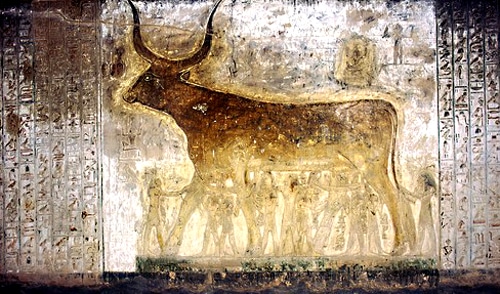
Nut: The Starry Sky
Nut, a significant figure in cosmology, was the Egyptian goddess of the sky. She was often depicted arching over the earth, her body adorned with stars. It was believed that she swallowed the sun every day, which traveled through her body overnight to be reborn at dawn.
According to ancient lore regarding the succession of divine rulers, Ra, the deity of the sun, held the world’s reins second in line. He proclaimed, “Let Nut not bear a child on any day of the annual cycle.” Back then, the year comprised only 360 days. Seeking a solution, Nut consulted Thoth, the deity of knowledge. Thoth hatched a scheme and challenged Khonsu, the moon god, whose luminance was almost comparable to Ra’s, to a game of chance. Each defeat meant Khonsu had to part with a fragment of his moonlit glow. After numerous losses, Nut accumulated enough of this light to fashion five additional days.
Ma’at: Cosmic Order Personified
Ma’at wasn’t just another deity but epitomized the core Egyptian values of order, truth, and balance. Her iconic symbol, an ostrich feather, was instrumental in the afterlife judgment process. Without Ma’at and her principles, the ancient Egyptians believed the universe would plunge into chaos.
Ancient Egyptian legal traditions are sparsely documented in existing historical texts. The essence of justice was more captured in the concept of Maat than in a comprehensive list of legal provisions. Maat symbolized the foundational ethics and values that served as the canvas for meting justice, always centered on truth and equity. Starting from the Fifth Dynasty, around 2510-2370 BCE, the official overseeing justice was dubbed the “Custodian of Maat.” In subsequent eras, it became customary for judicial figures to adorn themselves with depictions of Maat.
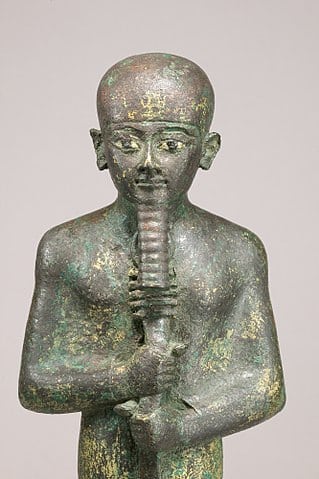
Ptah’s Divine Craftsmanship
The deity Ptah, revered in the city of Memphis, held a unique creation story. Rather than physical labor, he conceived the world through his thoughts and words. This emphasizes the importance and power of intellect and speech in the ancient Egyptian worldview.
The devotion to Ptah swiftly permeated throughout ancient Egypt.
Ptah’s leading priests became indispensable as the Old Kingdom ushered in significant royal endeavors. Collaborating closely with the vizier, they became the primary architects and eminent artisans, taking charge of embellishing the royal burial structures.
During the era of the New Kingdom, Ptah’s worship underwent various evolutions, notably in Memphis, his native place, and Thebes.In Thebes, the artisans working on the royal graves revered him as the guardian of artisans. Consequently, a special chamber, “The Sanctuary of Listening Ptah,” was erected close to Deir el-Medina, the community that housed these skilled workers. In Memphis, the structure encircling the god’s shrine was adorned with large sculpted ears, underlining his function as the Egyptian god that hears prayers.

Nephthys: Osiris’ Support
While Nephthys might not be as renowned as some gods, her role in Egyptian mythology is pivotal. Primarily known as the goddess of night and mourning, she partnered with her sister Isis in the rituals to resurrect Osiris, showcasing the strong bonds of family in divine tales.
Nephthys was a close ally to the fierce god Set and stands as a divine emblem of life’s concluding chapters, much like how Isis embodies life’s commencement. Within the context of ancient Egyptian religious beliefs and cosmological narratives, Nephthys was often hailed as the “Guardian Goddess” or the “Supreme Deity.” These time-honored Egyptian religious scripts depict a deity whose essence is intertwined with divine intervention and vigilant protection.

Khonsu’s Lunar Cycle
Khonsu, a moon god depicted with a falcon’s head, played a vital role in marking time. Bearing the epithet “The Voyager” aptly captures the moon’s nightly journey across the heavens. He was also known by other designations like the Guardian, Trailblazer, Protector, and Healer, underscoring his role as a sentinel for nocturnal travelers.
As a beacon in the darkness, Khonsu was summoned for protection against untamed beasts and assistance in healing rituals. Legends suggest that as Khonsu ushered in the crescent moon’s glow, it marked a time of fertility for women and livestock alike and breathed rejuvenating air into every being.

Imhotep’s Elevation to an Egyptian God
Originally, Imhotep wasn’t a deity but a historical figure known for his architectural prowess, notably for designing the step pyramid. Due to his significant contributions, he was deified after his death, highlighting that, occasionally, mortals could join the ranks of gods in ancient Egyptian beliefs.
Imhotep holds the rare distinction of being among the limited non-royal figures in Egypt who were immortalized as deities posthumously. Until the recent centuries, such an honor was bestowed upon only a few non-royal individuals. Memphis stood as the epicenter of his worship. Despite relentless quests, the exact resting place of Imhotep eludes discovery, with many speculating it’s concealed somewhere within Saqqara.
Imhotep’s reputation evolved two millennia after his passing as the sands of time shifted, casting him as a deity of medicine and restorative powers. Over time, his persona became intertwined with Thoth, the Egyptian god renowned for wisdom in architecture, mathematics, medicine, and as the protector of scribes, leading to the amalgamation of their respective cults.

Neith: Crafting Destiny
Neith, revered as one of the oldest Egyptian deities, had many responsibilities. Besides her roles in war and hunting, she was the “Weaver of the World,” illustrating the idea that both destinies of gods and mortals were interconnected and finely crafted.
Often heralded as the inaugural creator, it was believed that she sculpted the cosmos and dictated its mechanics. In certain age-old Egyptian tales of origin, Neith emerges as the progenitor of Ra and Apep. Recognized as a deity of water, she was perceived as the maternal figure of Sobek, the iconic crocodile. This water connection, particularly the Nile, occasionally positioned her as Khnum’s consort, and at times, she was linked with the birthplace of the River Nile. Within specific spiritual hubs, she was also tied to the Nile Perch, embodying the central figure of a divine trio.
Neith, revered as the deity of craftsmanship and the textile arts, was believed to weave the fabric of existence anew on her celestial loom daily. Inside the temple walls at Esna, inscriptions recount a tale where Neith births the Nun, the primal land, from the initial waters. She manifested every thought, giving rise to the pantheon of thirty deities of Egyptian gods. Given her self-sufficient nature, she’s often hailed as the “Unwed Mother Deity.”
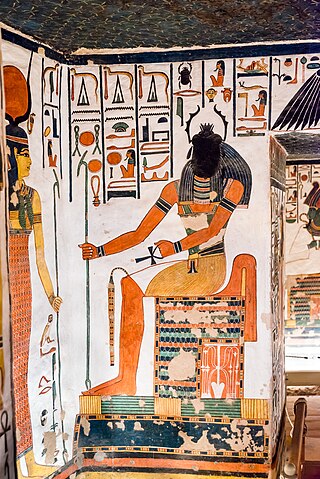
Khepri’s Dawn Symbolism
Khepri, sometimes portrayed as a scarab, was intrinsically linked to the rising sun. He represented rebirth and transformation and reminded the ancient Egyptians of life’s cyclical nature, where each dawn signified new beginnings.
Khepri, while not central to any particular religious cult, remained in the shadow of the prominent solar deity, Ra. However, the theories of creation in Heliopolis and later in Thebes incorporated this sun deity. Khepri and Atum were often perceived as reflections of Ra’s daily cycle: Khepri symbolized dawn, Ra stood for noon, and Atum represented dusk.
As an Egyptian god, Khepri held four core roles: creator, guardian, solar deity, and deity of rebirth. The prevailing faith around Khepri was rooted in his power to rejuvenate, mirroring how he breathed life into the sun each daybreak. Ancient tombs from pre-dynastic periods have unveiled mummified scarab beetles and related talismans, suggesting that reverence for Khepri as an Egyptian god dates back to the early epochs of Egyptian civilization.

Apep’s Eternal Struggle with Ra
Apep, the formidable serpent of the underworld, was Ra’s consistent antagonist. As Ra journeyed through the underworld, Apep tried to swallow him every night, aiming to engulf the world in eternal night. This struggle underlined the perpetual battle between order and chaos.
Legends of Apep’s confrontations with Ra grew more intricate during the New Kingdom era. In these narratives, Apep was bound to stay beneath the horizon, thus naturally associating him with the realm of the deceased. Depending on the tale, Apep would either await Ra at Bakhu, a mountain in the west where the sun descended or ambush him just before sunrise in the Tenth region of the Night.
Due to his vast array of potential dwelling places, he was often called the World Surrounder. It was believed that his fearsome roar would echo throughout the netherworld. Some myths suggested that Apep was confined to this realm either because he was the former primary deity dethroned by Ra or due to his malevolent nature, leading to his incarceration.
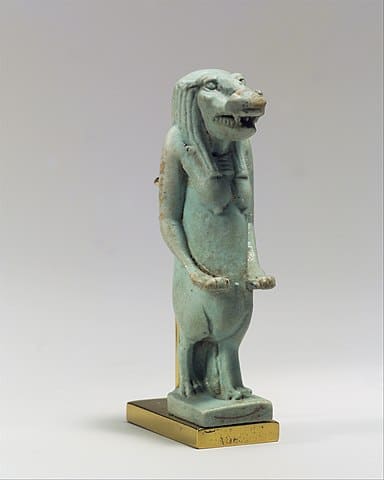
Taweret: Protector of Mothers
Taweret, a hippopotamus goddess, might appear intimidating, but she was primarily invoked for childbirth protection. Representing both the dangers and safeguards of childbirth, she showcases the duality of numerous Egyptian gods.
In specific versions of a prevalent legend, the Eye of Ra, upset with her patriarch, ventures to Nubia, transforming into a lioness. When she ultimately returns to Egypt, she takes on the shape of a hippopotamus, often believed to be Taweret, subsequently causing the Nile to flood. This tale underscores Taweret’s essential role as a deity of procreation and renewal.
Some experts suggest that her involvement in the Nile’s surge is the reason she was often referred to as the “Lady of Pristine Waters.” Nevertheless, her equivalent contribution to revitalizing the deceased is also significant when considering this title. She not only bestowed life upon the living through birth and the river’s rise but also purified the departed, ensuring their safe passage to the world beyond.

Isis: Magic and Motherhood
Isis, one of the most revered deities, was renowned for her magical prowess. She was pivotal in resurrecting Osiris and was also profoundly associated with motherhood and protection, embodying love and devotion.
Isis, revered for her profound magical prowess, possessed the capability to resurrect Osiris and ensure the safety and health of Horus, showcasing not just her strength but also her strategic wisdom. She was often lauded as having intelligence surpassing countless deities. In the tales from the New Kingdom, particularly “The Contendings of Horus and Set,” she frequently employs her magic and wit to gain the upper hand against Set, who is embroiled in a dispute with Horus, her son.
In one tale, she morphs into a maiden embroiled in a familial dispute echoing Set’s wrongful takeover of Osiris’s throne. When Set decries this as unfair, Isis retorts, pointing out his hypocrisy. In subsequent accounts, she harnesses her transformative magic to defeat Set and his allies.
Various Isis-centric tales serve as introductions to magical scriptures, providing mythological context for the enchantment’s objectives. In one notable enchantment, Isis crafts a serpent that bites and weakens the superior deity, Ra. She then proposes to heal Ra in exchange for his elusive, potent true name. After persistent persuasion, Ra divulges his name, which Isis then bestows upon Horus, amplifying his regal stature. This narrative might be an attempt to rationalize why Isis’s magical prowess eclipsed that of other gods. Interestingly, even though she employs her magic to dominate Ra in the story, it’s suggested that her extraordinary abilities were innate, even before she learned Ra’s secret name.

Sobek’s Crocodilian Might
The crocodile god, Sobek, exemplified both the perils and protections of the Nile. As a deity, he was both feared and respected, much like the actual crocodiles of the Nile, which were both a threat and a vital part of the ecosystem.
Sobek stands out predominantly as a fierce and primal god, embodying the traits of his symbolic creature, the robust Nile crocodile. He carries epithets like “he who revels in theft,” “he who consumes as he couples,” and “sharp-toothed.” Yet, beyond this fierce exterior, Sobek also plays a compassionate role in numerous revered tales. Once he became linked with Horus and was integrated into the trio of Osiris, Isis, and Horus during the Middle Kingdom era, his character took on a healing aspect, notably as a restorer of the slain Osiris, whom Set killed.
This role as a healer translated into Sobek being seen as a guardian. His inherent aggression became a force against malevolence, safeguarding the innocent. This led to increased worship, and he received numerous offerings, especially in the later epochs of ancient Egyptian culture. Especially during the Ptolemaic and Roman times in Egypt, it became a practice to mummify crocodiles and offer them at Sobek’s temples.
The tales of Egyptian Gods provide a captivating window into ancient Egypt’s spiritual and cultural landscape. These deities, with their distinctive attributes and enthralling narratives, have left an indelible mark on the tapestry of human history. They serve not just as figures of worship but also as reflections of societal values, natural phenomena, and the intricate web of relationships that bound the world of the living with the realm of the divine. As we conclude our brief exploration, it’s evident that the allure of these gods transcends time, beckoning us to dive deeper, to understand more, and to continue appreciating the richness of this ancient civilization’s contributions to the world.





